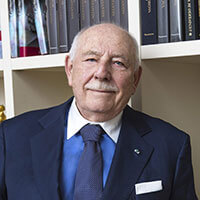For those who didn’t study Italian literature in school, Luigi Pirandello was one of the twentieth century’s most important authors, poets and playwrights. Winner of the Nobel Prize in Literature in 1934 for his “almost magical power to turn psychological analysis into good theatre,” in 1921 he wrote a play titled Six Characters in Search of an Author – a metatheatrical work whose characters, conscious of their role, act out the drama without being fully a part of it. Woody Allen uses a similar device in The Purple Rose of Cairo, as does George Clooney in coffee commercials I’m sure you have all seen.
What does this have to do with Fine Watchmaking? It has to do that recent goings-on at brands put me in mind of Pirandello and his play, with characters entering and exiting the stage at an almost frantic pace; one day in the role of chief executive, next day as managing director, then senior vice president or some other executive part. As though a puppet master had engaged them in a game of musical chairs. It’s a game I can imagine might make sense in the fashion industry that starts afresh each season – although playing musical chairs with, say, Karl Lagerfeld would have been suicidal.
Such behaviour, it would seem, is now the norm in Fine Watchmaking. Call me old-fashioned but in my day, loyalty towards a company – I say loyalty because dogs are faithful – was honoured, respected and rewarded. An employee would have a meritorious career with the same company, progressing through the ranks. Each advancement would be duly rewarded with a gift whose value acknowledged the importance of the competencies he or she had acquired over time, and that were to be safeguarded and cherished.
The dangers of marketing
In Fine Watchmaking, this “all change” (“putting out to pasture”, you might say) can be justified when taking on new markets or extending activity in certain areas of production or distribution, and acceptable when it concerns a brand’s “structure”. Not so when it happens at the highest levels, from chief executive to creative director, when there is a (huge) risk that it will have the opposite effect. These “sacrifices”, which prevent a good professional from building up their experience and competencies, become obstacles to long-term objectives, investments and strategies that are dropped to make way for the new ideas of the latest person to sit on the “musical chair”. Until the music stops again…
Not content with underestimating competencies, marketing has spawned a multitude of consultancies that companies use as shields.
This culture of change at all cost comes from marketing, a tentacular discipline with harmful consequences. Not content with underestimating the competencies behind the product (in particular when these are cultural and artistic), marketing has spawned a multitude of consultancies which companies use as shields at each restructuring and each new game of musical chairs. That way, when something goes wrong, they can lay the blame at the consultant’s door.
In an ecosystem as particular as Fine Watchmaking (we’re not talking here about rebar manufacturers, with all the respect we owe reinforcing bars), changes aren’t made simply as a means of getting by, of keeping up to standard. Changes are made, where appropriate, in order to improve standards. Let’s not forget that every brand has its history, DNA and, most of all, human capital. Managing all of this requires knowledge, competencies, experience and, above all, respect for these specificities that are the foundations of current success and the bedrock of future growth.












